Noah Constant
Shammie
Training LLMs over Neurally Compressed Text
Apr 04, 2024



Abstract:In this paper, we explore the idea of training large language models (LLMs) over highly compressed text. While standard subword tokenizers compress text by a small factor, neural text compressors can achieve much higher rates of compression. If it were possible to train LLMs directly over neurally compressed text, this would confer advantages in training and serving efficiency, as well as easier handling of long text spans. The main obstacle to this goal is that strong compression tends to produce opaque outputs that are not well-suited for learning. In particular, we find that text na\"ively compressed via Arithmetic Coding is not readily learnable by LLMs. To overcome this, we propose Equal-Info Windows, a novel compression technique whereby text is segmented into blocks that each compress to the same bit length. Using this method, we demonstrate effective learning over neurally compressed text that improves with scale, and outperforms byte-level baselines by a wide margin on perplexity and inference speed benchmarks. While our method delivers worse perplexity than subword tokenizers for models trained with the same parameter count, it has the benefit of shorter sequence lengths. Shorter sequence lengths require fewer autoregressive generation steps, and reduce latency. Finally, we provide extensive analysis of the properties that contribute to learnability, and offer concrete suggestions for how to further improve the performance of high-compression tokenizers.
Transfer Learning for Text Diffusion Models
Jan 30, 2024Abstract:In this report, we explore the potential for text diffusion to replace autoregressive (AR) decoding for the training and deployment of large language models (LLMs). We are particularly interested to see whether pretrained AR models can be transformed into text diffusion models through a lightweight adaptation procedure we call ``AR2Diff''. We begin by establishing a strong baseline setup for training text diffusion models. Comparing across multiple architectures and pretraining objectives, we find that training a decoder-only model with a prefix LM objective is best or near-best across several tasks. Building on this finding, we test various transfer learning setups for text diffusion models. On machine translation, we find that text diffusion underperforms the standard AR approach. However, on code synthesis and extractive QA, we find diffusion models trained from scratch outperform AR models in many cases. We also observe quality gains from AR2Diff -- adapting AR models to use diffusion decoding. These results are promising given that text diffusion is relatively underexplored and can be significantly faster than AR decoding for long text generation.
Beyond Human Data: Scaling Self-Training for Problem-Solving with Language Models
Dec 22, 2023Abstract:Fine-tuning language models~(LMs) on human-generated data remains a prevalent practice. However, the performance of such models is often limited by the quantity and diversity of high-quality human data. In this paper, we explore whether we can go beyond human data on tasks where we have access to scalar feedback, for example, on math problems where one can verify correctness. To do so, we investigate a simple self-training method based on expectation-maximization, which we call ReST$^{EM}$, where we (1) generate samples from the model and filter them using binary feedback, (2) fine-tune the model on these samples, and (3) repeat this process a few times. Testing on advanced MATH reasoning and APPS coding benchmarks using PaLM-2 models, we find that ReST$^{EM}$ scales favorably with model size and significantly surpasses fine-tuning only on human data. Overall, our findings suggest self-training with feedback can substantially reduce dependence on human-generated data.
Frontier Language Models are not Robust to Adversarial Arithmetic, or "What do I need to say so you agree 2+2=5?
Nov 15, 2023



Abstract:We introduce and study the problem of adversarial arithmetic, which provides a simple yet challenging testbed for language model alignment. This problem is comprised of arithmetic questions posed in natural language, with an arbitrary adversarial string inserted before the question is complete. Even in the simple setting of 1-digit addition problems, it is easy to find adversarial prompts that make all tested models (including PaLM2, GPT4, Claude2) misbehave, and even to steer models to a particular wrong answer. We additionally provide a simple algorithm for finding successful attacks by querying those same models, which we name "prompt inversion rejection sampling" (PIRS). We finally show that models can be partially hardened against these attacks via reinforcement learning and via agentic constitutional loops. However, we were not able to make a language model fully robust against adversarial arithmetic attacks.
FreshLLMs: Refreshing Large Language Models with Search Engine Augmentation
Oct 05, 2023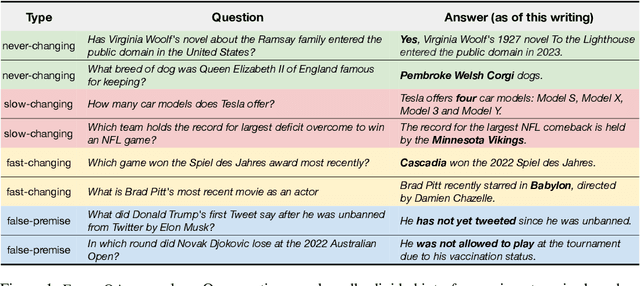



Abstract:Most large language models (LLMs) are trained once and never updated; thus, they lack the ability to dynamically adapt to our ever-changing world. In this work, we perform a detailed study of the factuality of LLM-generated text in the context of answering questions that test current world knowledge. Specifically, we introduce FreshQA, a novel dynamic QA benchmark encompassing a diverse range of question and answer types, including questions that require fast-changing world knowledge as well as questions with false premises that need to be debunked. We benchmark a diverse array of both closed and open-source LLMs under a two-mode evaluation procedure that allows us to measure both correctness and hallucination. Through human evaluations involving more than 50K judgments, we shed light on limitations of these models and demonstrate significant room for improvement: for instance, all models (regardless of model size) struggle on questions that involve fast-changing knowledge and false premises. Motivated by these results, we present FreshPrompt, a simple few-shot prompting method that substantially boosts the performance of an LLM on FreshQA by incorporating relevant and up-to-date information retrieved from a search engine into the prompt. Our experiments show that FreshPrompt outperforms both competing search engine-augmented prompting methods such as Self-Ask (Press et al., 2022) as well as commercial systems such as Perplexity.AI. Further analysis of FreshPrompt reveals that both the number of retrieved evidences and their order play a key role in influencing the correctness of LLM-generated answers. Additionally, instructing the LLM to generate concise and direct answers helps reduce hallucination compared to encouraging more verbose answers. To facilitate future work, we release FreshQA at github.com/freshllms/freshqa and commit to updating it at regular intervals.
UniMax: Fairer and more Effective Language Sampling for Large-Scale Multilingual Pretraining
Apr 18, 2023



Abstract:Pretrained multilingual large language models have typically used heuristic temperature-based sampling to balance between different languages. However previous work has not systematically evaluated the efficacy of different pretraining language distributions across model scales. In this paper, we propose a new sampling method, UniMax, that delivers more uniform coverage of head languages while mitigating overfitting on tail languages by explicitly capping the number of repeats over each language's corpus. We perform an extensive series of ablations testing a range of sampling strategies on a suite of multilingual benchmarks, while varying model scale. We find that UniMax outperforms standard temperature-based sampling, and the benefits persist as scale increases. As part of our contribution, we release: (i) an improved and refreshed mC4 multilingual corpus consisting of 29 trillion characters across 107 languages, and (ii) a suite of pretrained umT5 model checkpoints trained with UniMax sampling.
Character-Aware Models Improve Visual Text Rendering
Dec 20, 2022



Abstract:Current image generation models struggle to reliably produce well-formed visual text. In this paper, we investigate a key contributing factor: popular text-to-image models lack character-level input features, making it much harder to predict a word's visual makeup as a series of glyphs. To quantify the extent of this effect, we conduct a series of controlled experiments comparing character-aware vs. character-blind text encoders. In the text-only domain, we find that character-aware models provide large gains on a novel spelling task (WikiSpell). Transferring these learnings onto the visual domain, we train a suite of image generation models, and show that character-aware variants outperform their character-blind counterparts across a range of novel text rendering tasks (our DrawText benchmark). Our models set a much higher state-of-the-art on visual spelling, with 30+ point accuracy gains over competitors on rare words, despite training on far fewer examples.
FRMT: A Benchmark for Few-Shot Region-Aware Machine Translation
Oct 01, 2022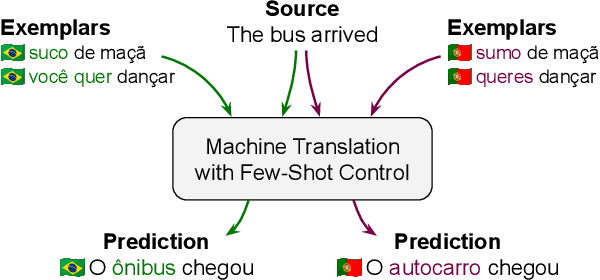
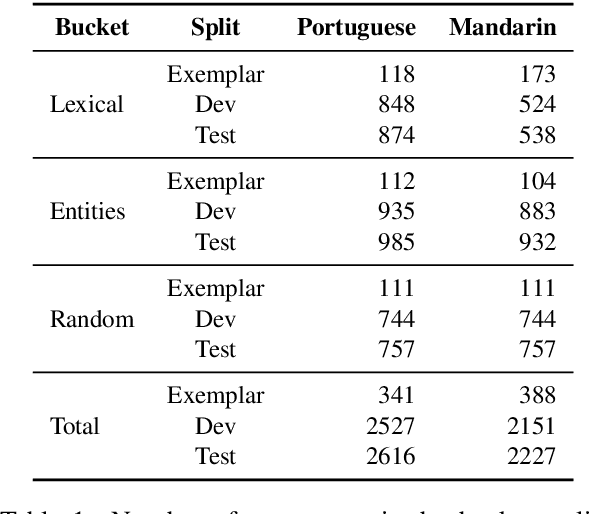
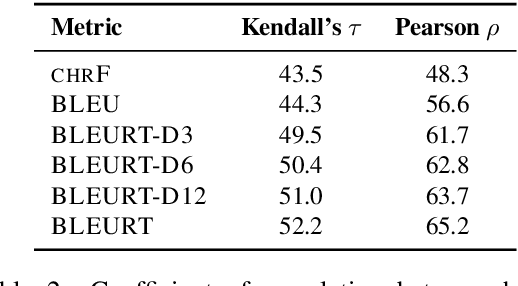
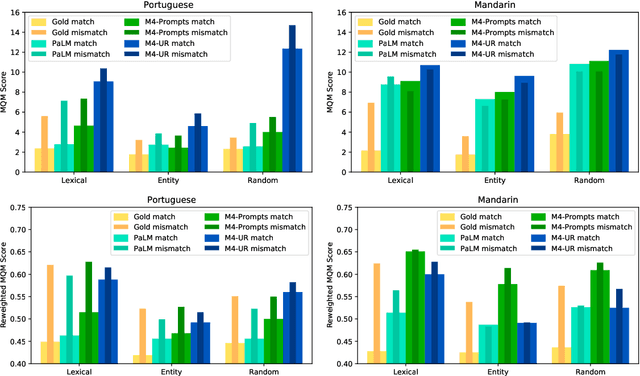
Abstract:We present FRMT, a new dataset and evaluation benchmark for Few-shot Region-aware Machine Translation, a type of style-targeted translation. The dataset consists of professional translations from English into two regional variants each of Portuguese and Mandarin Chinese. Source documents are selected to enable detailed analysis of phenomena of interest, including lexically distinct terms and distractor terms. We explore automatic evaluation metrics for FRMT and validate their correlation with expert human evaluation across both region-matched and mismatched rating scenarios. Finally, we present a number of baseline models for this task, and offer guidelines for how researchers can train, evaluate, and compare their own models. Our dataset and evaluation code are publicly available: https://bit.ly/frmt-task
Bidirectional Language Models Are Also Few-shot Learners
Sep 29, 2022



Abstract:Large language models such as GPT-3 (Brown et al., 2020) can perform arbitrary tasks without undergoing fine-tuning after being prompted with only a few labeled examples. An arbitrary task can be reformulated as a natural language prompt, and a language model can be asked to generate the completion, indirectly performing the task in a paradigm known as prompt-based learning. To date, emergent prompt-based learning capabilities have mainly been demonstrated for unidirectional language models. However, bidirectional language models pre-trained on denoising objectives such as masked language modeling produce stronger learned representations for transfer learning. This motivates the possibility of prompting bidirectional models, but their pre-training objectives have made them largely incompatible with the existing prompting paradigm. We present SAP (Sequential Autoregressive Prompting), a technique that enables the prompting of bidirectional models. Utilizing the machine translation task as a case study, we prompt the bidirectional mT5 model (Xue et al., 2021) with SAP and demonstrate its few-shot and zero-shot translations outperform the few-shot translations of unidirectional models like GPT-3 and XGLM (Lin et al., 2021), despite mT5's approximately 50% fewer parameters. We further show SAP is effective on question answering and summarization. For the first time, our results demonstrate prompt-based learning is an emergent property of a broader class of language models, rather than only unidirectional models.
Reducing Retraining by Recycling Parameter-Efficient Prompts
Aug 10, 2022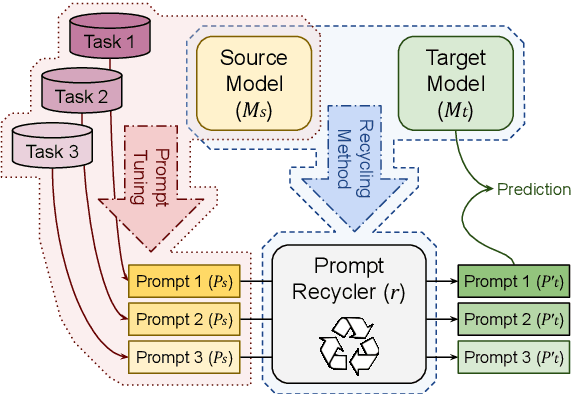

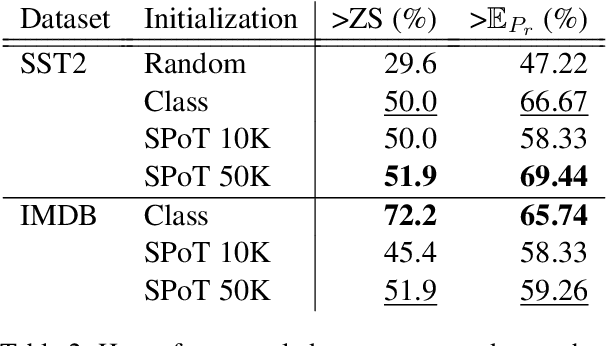
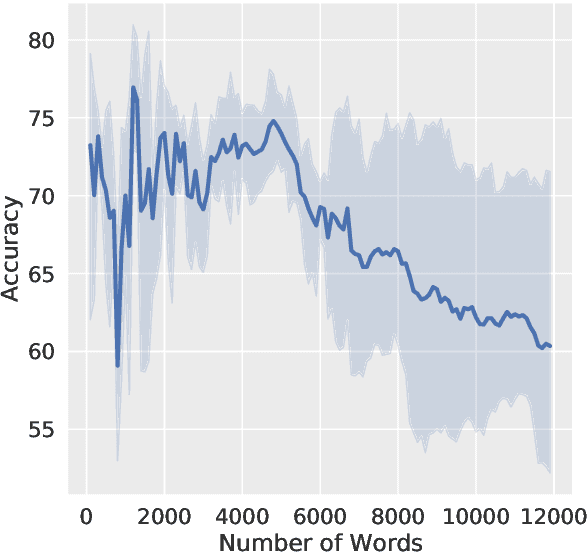
Abstract:Parameter-efficient methods are able to use a single frozen pre-trained large language model (LLM) to perform many tasks by learning task-specific soft prompts that modulate model behavior when concatenated to the input text. However, these learned prompts are tightly coupled to a given frozen model -- if the model is updated, corresponding new prompts need to be obtained. In this work, we propose and investigate several approaches to "Prompt Recycling'" where a prompt trained on a source model is transformed to work with the new target model. Our methods do not rely on supervised pairs of prompts, task-specific data, or training updates with the target model, which would be just as costly as re-tuning prompts with the target model from scratch. We show that recycling between models is possible (our best settings are able to successfully recycle $88.9\%$ of prompts, producing a prompt that out-performs baselines), but significant performance headroom remains, requiring improved recycling techniques.
 Add to Chrome
Add to Chrome Add to Firefox
Add to Firefox Add to Edge
Add to Edge